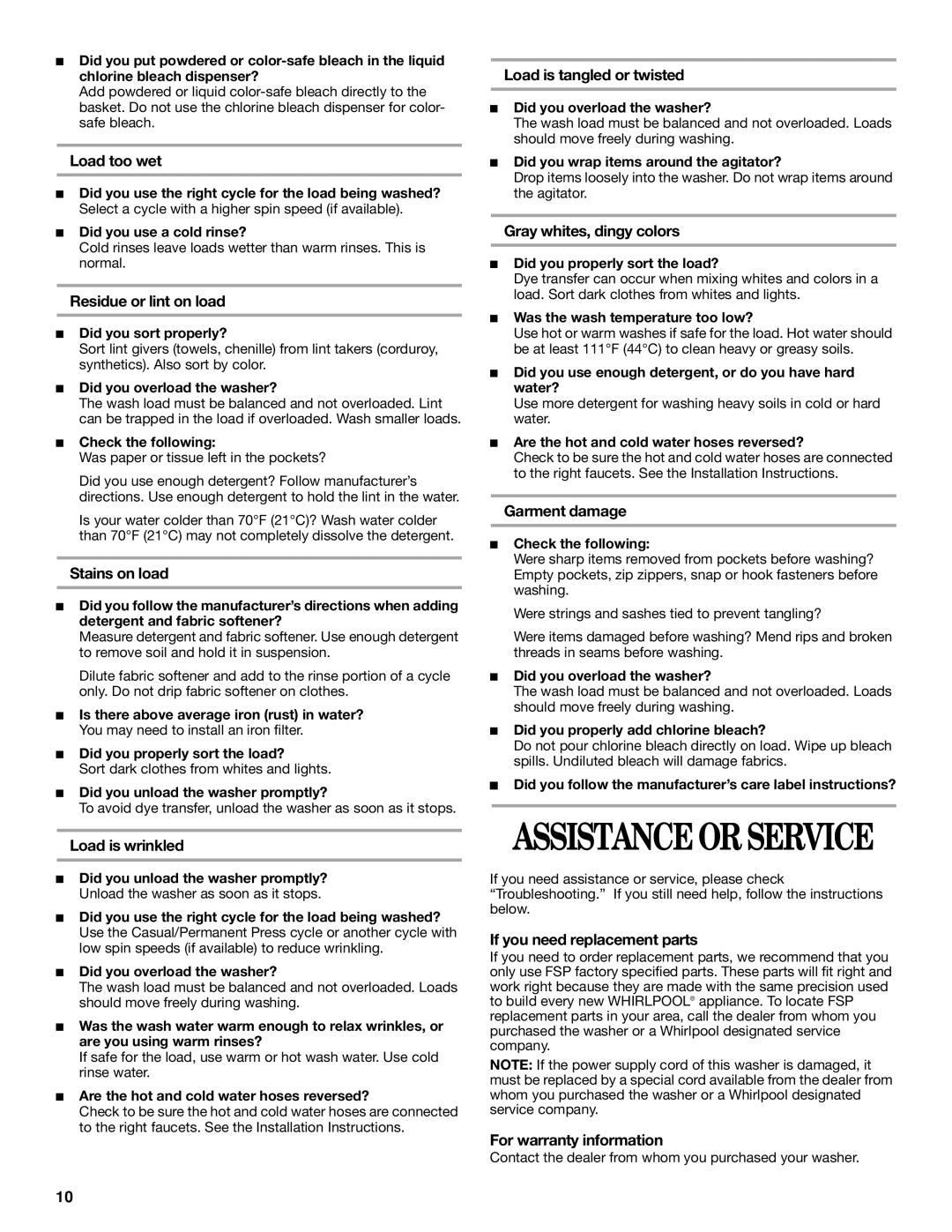
■Did you put powdered or
Add powdered or liquid
Load too wet
■Did you use the right cycle for the load being washed? Select a cycle with a higher spin speed (if available).
■Did you use a cold rinse?
Cold rinses leave loads wetter than warm rinses. This is normal.
Residue or lint on load
■Did you sort properly?
Sort lint givers (towels, chenille) from lint takers (corduroy, synthetics). Also sort by color.
■Did you overload the washer?
The wash load must be balanced and not overloaded. Lint can be trapped in the load if overloaded. Wash smaller loads.
■Check the following:
Was paper or tissue left in the pockets?
Did you use enough detergent? Follow manufacturer’s directions. Use enough detergent to hold the lint in the water.
Is your water colder than 70°F (21°C)? Wash water colder than 70°F (21°C) may not completely dissolve the detergent.
Stains on load
■Did you follow the manufacturer’s directions when adding detergent and fabric softener?
Measure detergent and fabric softener. Use enough detergent to remove soil and hold it in suspension.
Dilute fabric softener and add to the rinse portion of a cycle only. Do not drip fabric softener on clothes.
■Is there above average iron (rust) in water? You may need to install an iron filter.
■Did you properly sort the load?
Sort dark clothes from whites and lights.
■Did you unload the washer promptly?
To avoid dye transfer, unload the washer as soon as it stops.
Load is wrinkled
■Did you unload the washer promptly? Unload the washer as soon as it stops.
■Did you use the right cycle for the load being washed? Use the Casual/Permanent Press cycle or another cycle with low spin speeds (if available) to reduce wrinkling.
■Did you overload the washer?
The wash load must be balanced and not overloaded. Loads should move freely during washing.
■Was the wash water warm enough to relax wrinkles, or are you using warm rinses?
If safe for the load, use warm or hot wash water. Use cold rinse water.
■Are the hot and cold water hoses reversed?
Check to be sure the hot and cold water hoses are connected to the right faucets. See the Installation Instructions.
Load is tangled or twisted
■Did you overload the washer?
The wash load must be balanced and not overloaded. Loads should move freely during washing.
■Did you wrap items around the agitator?
Drop items loosely into the washer. Do not wrap items around the agitator.
Gray whites, dingy colors
■Did you properly sort the load?
Dye transfer can occur when mixing whites and colors in a load. Sort dark clothes from whites and lights.
■Was the wash temperature too low?
Use hot or warm washes if safe for the load. Hot water should be at least 111°F (44°C) to clean heavy or greasy soils.
■Did you use enough detergent, or do you have hard water?
Use more detergent for washing heavy soils in cold or hard water.
■Are the hot and cold water hoses reversed?
Check to be sure the hot and cold water hoses are connected to the right faucets. See the Installation Instructions.
Garment damage
■Check the following:
Were sharp items removed from pockets before washing? Empty pockets, zip zippers, snap or hook fasteners before washing.
Were strings and sashes tied to prevent tangling?
Were items damaged before washing? Mend rips and broken threads in seams before washing.
■Did you overload the washer?
The wash load must be balanced and not overloaded. Loads should move freely during washing.
■Did you properly add chlorine bleach?
Do not pour chlorine bleach directly on load. Wipe up bleach spills. Undiluted bleach will damage fabrics.
■Did you follow the manufacturer’s care label instructions?
ASSISTANCE ORSERVICE
If you need assistance or service, please check “Troubleshooting.” If you still need help, follow the instructions below.
If you need replacement parts
If you need to order replacement parts, we recommend that you only use FSP factory specified parts. These parts will fit right and work right because they are made with the same precision used to build every new WHIRLPOOL® appliance. To locate FSP replacement parts in your area, call the dealer from whom you purchased the washer or a Whirlpool designated service company.
NOTE: If the power supply cord of this washer is damaged, it must be replaced by a special cord available from the dealer from whom you purchased the washer or a Whirlpool designated service company.
For warranty information
Contact the dealer from whom you purchased your washer.
10
